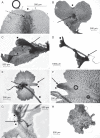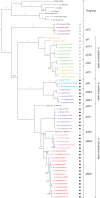Apomixis and reticulate evolution in the Asplenium monanthes fern complex
- PMID: 22984165
- PMCID: PMC3503490
- DOI: 10.1093/aob/mcs202
Apomixis and reticulate evolution in the Asplenium monanthes fern complex
Abstract
Background and aims: Asexual reproduction is a prominent evolutionary process within land plant lineages and especially in ferns. Up to 10 % of the approx. 10 000 fern species are assumed to be obligate asexuals. In the Asplenium monanthes species complex, previous studies identified two triploid, apomictic species. The purpose of this study was to elucidate the phylogenetic relationships in the A. monanthes complex and to investigate the occurrence and evolution of apomixis within this group.
Methods: DNA sequences of three plastid markers and one nuclear single copy gene were used for phylogenetic analyses. Reproductive modes were assessed by examining gametophytic and sporophyte development, while polyploidy was inferred from spore measurements.
Key results: Asplenium monanthes and A. resiliens are confirmed to be apomictic. Asplenium palmeri, A. hallbergii and specimens that are morphologically similar to A. heterochroum are also found to be apomictic. Apomixis is confined to two main clades of taxa related to A. monanthes and A. resiliens, respectively, and is associated with reticulate evolution. Two apomictic A. monanthes lineages, and two putative diploid sexual progenitor species are identified in the A. monanthes clade.
Conclusions: Multiple origins of apomixis are inferred, in both alloploid and autoploid forms, within the A. resiliens and A. monanthes clades.
Figures






References
-
- Adams CD. In: Asplenium. In. Davidse G, Sousa M, Knapp S, editors. Mexico: Universidad Nacional Autónoma de México; 1995. pp. 290–324. Flora Mesoamericana.
-
- Aldrich J, Cherney BW, Merlin E, Christopherson L. The role of insertions/deletions in the evolution of the intergenic region between psbA and trnH in the chloroplast genome. Current Genetics. 1988;14:137–146. - PubMed
-
- Ammal LS, Bahavanandan KV. Cytological studies on the genus Asplenium Linn. Indian Fern Journal. 1991;8:69–73.
-
- Asker SE, Jerling L. Apomixis in plants. London: CRC Press; 1992.
-
- Barrington DS, Paris CA, Ranker TA. Systematic inferences from spore and stomate size in the ferns. American Fern Journal. 1986;76:149–159.

